Environmental testing plays a crucial role in advancing green technology, ensuring that innovations are not only effective but also environmentally sustainable.
In recent years, the urgency to mitigate climate change and preserve our planet has driven the rapid development of green technology. From renewable energy solutions to sustainable manufacturing practices, these innovations hold the promise of a cleaner, more sustainable future.
The Importance of Environmental Testing
Ensuring Effectiveness
Environmental testing evaluates how green technologies perform under various conditions. It assesses their durability, efficiency, and reliability in real-world applications. By subjecting these technologies to simulated environmental stressors such as temperature extremes, humidity, and mechanical strain, researchers can identify weaknesses and optimize designs for maximum performance.
Minimizing Environmental Impact
Another critical aspect of environmental testing is its role in minimizing the environmental footprint of green technologies. By testing for factors like energy consumption, material toxicity, and waste generation, developers can make informed decisions that reduce adverse environmental effects throughout a product's lifecycle. This proactive approach not only ensures compliance with regulatory standards but also enhances sustainability credentials.
Innovations in Environmental Testing
Advancements in environmental testing methodologies have paralleled those in green technology itself. Modern techniques include accelerated aging tests, life cycle assessments, and eco-design evaluations. These methods enable researchers to gather comprehensive data on a technology's environmental impact from inception to disposal, fostering continuous improvement and innovation.
Conclusion
Environmental testing is not just a regulatory requirement but a cornerstone of responsible innovation in green technology. By rigorously assessing performance, minimizing environmental impacts, and driving continuous improvement, environmental testing ensures that green technologies deliver on their promise of sustainability. As we look towards a future shaped by climate resilience and resource efficiency, the role of environmental testing will only grow more vital in driving positive environmental outcomes.








